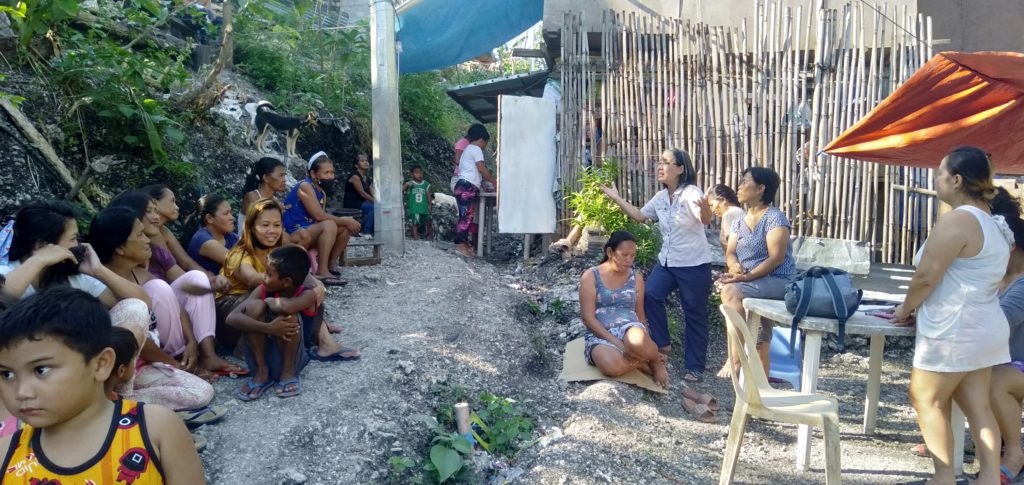The Visayas Primary Healthcare Services has just completed its one year project, “Building resilient communities: integrating primary health care in disaster risk reduction and management.”
The project which started in August 2015 is supported by the Unitarian Universalist Service Committee (UUSC). It responded to the needs of the people in Bantayan Island for primary health care services and increased capacities to prepare and manage health emergencies and disasters.
The project worked in partnership with the people’s organizations in the four communities, namely: Lipayran Farmers and Fisherfolks association (LIFFA), Patao Drivers and Fisherfolks Association (PADFA), Kampinganon United Farmers Association (KUFA), and San Agustin Farmers and Fisherfolks Association (SAFFA).
Trainings were conducted on disaster-risk reduction management for the four people’s organizations was conducted on September and October 2015. Spot maps, hazard maps and resource maps were made. Disaster risk reduction and management plans were then formulated by each community. Disaster kits were also distributed to them.
The communities made surveys of family members, the hazards, infrastructures, capacities, common diseases and needs in the communities. They also regularly updated the disaster maps to include all data as much as possible. They also came up with a warning system. Such disaster risk mapping, the identification of their most vulnerable aspects as well as measures the community will put into place will increase their resilience to disasters and health preparedness.
The people’s organizations also gathered resources such as funds and materials such as ropes, radios, bells, and others that would be used during disasters.
The people’s organizations successfully conducted their planned evacuation drills in their barangays together with the rest of the community in cooperation with the barangay councils, Municipal Disaster Risk Reduction Management Office (MDDRMO), Bureau of Fire and Protection, and school teachers. Through actual putting in place of their evacuation plans, they were able to see the weaknesses and strengths which they used to modify their plans and make them more effective when disasters strike.
Trainings on primary health care were conducted for community health workers (CHWs) to prepare and to manage health emergencies and disasters on December 2015 to January 2016. The topics included (a) national and local health situation, (b) community-based health program (CBHP) orientation, (c) vital signs taking: blood pressure, temperature, pulse rate, respiratory rate, (d) home remedies: water therapy, cupping therapy, (e) control of acute respiratory infection (ARI), (f) control of diarrheal diseases (CDD), (g) nutrition and breastfeeding, (h) proper hygiene and environmental sanitation and (i) review of CRM.
The second phase of basic health skill training included the topics of (a) anatomy and physiology (b) history and physical examination (c) ventusa (d) herbal making (e) first aid (f) immunization (g) hypertension (h) acupressure (i) teaching learning communication skills.
Trained CHWs rendered basic promotive, preventive and selected curative services to their communities. The CHWs monitored blood pressure, did ventusa, and acupressure. They also treated residents with eczema through herbal medicines and gave first aid to wounded patients. Through home visitations, residents were taught about home remedies such as water therapy, steam inhalation, environmental sanitation and proper hygiene and community resiliency model skills. Patients were referred to government health facilities or the rural health units for further treatment. CHWs mobilized the residents in clean-up drives in their community. They also conducted health education classes on environmental sanitation, nutrition and breastfeeding, herbal medicines, acute respiratory tract infection, control of diarrheal disease, and hypertension.
CHWs conducted health campaigns. Children were weighed and malnourished children had a feeding program. Promoting breastfeeding was also done among mothers in the communities. Hypertensive patients had monitoring of their blood pressure and made to understand the need for regular check up, intake of medicines and measures to prevent complications such as heart attack and stroke. The CHWs also promoted the use of locally available herbs for herbal medicine.
Coordination on disaster management was established between the people’s organizations and the barangay and municipality disaster risk reduction and management (DRRM) councils. The local government units and the people’s organizations came up with an integrated plan. Community health workers are now members of the barangay disaster risk reduction committees. The people’s organizations and the barangay councils are now coordinating their activities and implementing their plans together.
The community health workers have also become responders in the municipal risk reduction management offices of the local government units. They are assigned to handle psychosocial support in times of disasters and island wide activities such as during the Lenten seasons.
The barangay councils are supporting the activities of the people’s organizations. They are helping in the campaigns of the people’s organizations.
Through meetings with the barangay councils, the people’s organizations in Kampinganon and Lipayran were able to know that the barangay councils did not have disaster plans. Thus, they facilitated the MDRRM councils to conduct trainings in their barangays in order for them to know how to make disaster plans for the barangay. After the trainings on disaster management orientation and first aid, were conducted, the barangays conducted fire drills and earthquake drills. The disaster preparedness plan of the people’s organization of Lipayran was adopted by the barangay council which did not have its own plan.
In synthesis, the project saw that there was a need to capacitate the people’s organizations on disaster risk reduction and management, Bantayan island being highly vulnerable to disasters and experience had proven that being poorly prepared resulted in great damage to infrastructure and shelter and exacted a heavy toll on people’s lives. Capacity building and empowerment of the people is the key to address this need and the project thus centered on trainings on DRRM for the leaders of the people’s organizations so that a community-based disaster management program was established with the people’s active participation. Furthermore, because health needs of the people have generally been neglected in past disasters, it was thus necessary to incorporate health skills trainings with DRRM trainings.



